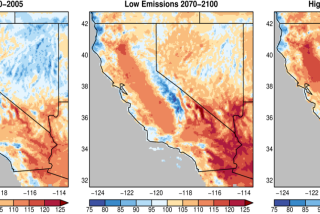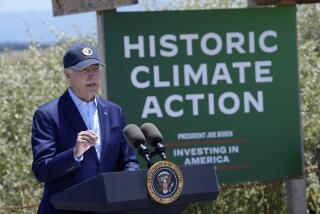Coal at heart of climate battle
WASHINGTON — Every time a new coal-fired power plant is proposed anywhere in the United States, a lawyer from the Sierra Club or an allied environmental group is assigned to stop it, by any bureaucratic or legal means necessary.
They might frame the battle as a matter of zoning or water use, but the larger war is over global warming: Coal puts twice as much temperature-raising carbon dioxide into the atmosphere as natural gas, second to coal as the most common power plant fuel.
The plant-by-plant strategy is part of a campaign by environmentalists to force the federal government to deal with climate change. The fights are scattered from Georgia to Wyoming, from Illinois to Texas, but the ultimate target is Washington, where the Bush administration has resisted placing limits on carbon dioxide and Congress has yet to act on a global warming bill.
The campaign against new coal-powered plants has infuriated utilities, which say the environmentalists’ tactics are an abuse of the regulatory and judicial systems. They are counterpunching with ads, lobbying and court briefs of their own, bringing the clash over coal to a pitch that rivals the environmental and legal fights over nuclear power decades ago.
The environmental coalition, which includes the Natural Resources Defense Council, Environmental Defense Fund and Environmental Integrity Project, claims 65 victories over the last three years. The Sierra Club is coordinating opposition to about 50 additional power plant proposals.
“We have a national presence, so we’re sort of mission control,” said Pat Gallagher, director of the Sierra Club’s environmental law program.
The goal: “We hope to clog up the system,” said David Bookbinder, the Sierra Club’s chief climate counsel. “It’s putting pressure on Congress to put together a comprehensive plan.”
Utilities and industry groups acknowledge that the environmentalists have been responsible for stopping some coal plants that otherwise would have been built. But the number is “nowhere near” 65, said Jeff Holmstead, a former EPA official who is now an industry lobbyist.
The partners in the anti-coal crusade are picking fights over any and all generators that use coal “regardless of merit,” said Brendan Collins, a lawyer in Philadelphia who represents utilities and power plant developers. “They are doing it in a way that is unfair.”
Since a meeting in Washington last summer, the partners in the anti-coal crusade have been focusing more squarely on carbon dioxide emissions in their local skirmishes, hoping to create precedents for dealing with a pollutant that is not federally regulated.
Their first high-profile victory came in Kansas last October, when state regulators denied a request by Sunflower Electric Co. for an air-quality permit for two 700-megawatt generators that would run on coal in the town of Holcomb.
The Sierra Club petitioned the state’s health and environment secretary, Roderick L. Bremby, to deny the air-quality permit on grounds of carbon dioxide emissions.
“I believe it would be irresponsible to ignore emerging information about the contribution of carbon dioxide and other greenhouse gases to climate change and the potential harm to our environment and health if we do nothing,” Bremby said at the time.
Ever since, the state courts and Legislature have been haggling over coal and carbon dioxide in Kansas, and Sunflower has been unable to proceed.
Nick Persampieri, a Denver-based attorney for the environmental law firm Earthjustice, represents the Sierra Club in opposition to the Sunflower plant. He works closely with the Sierra Club’s Kansas chapter. “You could argue that power plants harm everyone all over the country, but we always have somebody local to help us get standing” in court, he said.
Bookbinder is the Sierra Club’s point man against a proposed power plant on tribal land in Utah, a case that shows the scope of the anti-coal push.
Usually he focuses on big-picture, national litigation from his Capitol Hill office. Bookbinder was one of the original petitioners in last spring’s landmark Supreme Court decision that the EPA has authority to regulate carbon dioxide as a pollutant. But when he found himself with a block of free time last fall, he told Sierra Club headquarters in San Francisco, “I’ll take a coal plant.”
He received this mission: Halt a project by six electric cooperatives that run the Bonanza generator on the Uintah and Ouray Indian reservation. The co-ops, operating as Deseret Power, want to add a new unit with the capacity to manufacture 110 megawatts of electricity, about a fifth the capacity of the average power plant.
Bookbinder spied a big opportunity in the small project. Because the Bonanza plant is on property held in trust for Indians by the U.S. government, it was the Environmental Protection Agency, not a state, that issued the permit allowing the co-ops to proceed.
Bookbinder persuaded an administrative appeals board to consider overruling the EPA’s permit on the grounds that it would vent more than 3 million tons of carbon dioxide into the atmosphere each year. Oral arguments are scheduled for late May, and a decision is expected near the end of the summer.
If Bookbinder is successful, a ruling would affect any project that comes before the EPA, which has permitting authority for power plants in eight states, all federally owned land, Puerto Rico, Guam and the Northern Mariana Islands.
Deseret’s lawyer, Steffen N. Johnson, declined comment.
But this time, industry groups are jumping into the fray in a big way. “Where it’s going to be precedential, we will be getting involved,” said Russell Frye, who filed a half-inch-thick brief last month that supports the power plant on behalf of seven powerful trade associations, including the American Petroleum Institute, Chamber of Commerce of the United States, the American Chemistry Council and the National Assn. of Manufacturers.
Various business groups are discussing how to handle the environmentalists’ challenges in a more comprehensive way, but industry sources said their members have such a wide range of positions on climate change that it’s been difficult. Some suggest bringing conspiracy charges against the environmentalists if they can find instances in which the national groups recruited locals to allow them to file legal papers that they couldn’t have filed otherwise. But “no one has the guts,” said one industry lawyer.
Instead, Collins and two law partners wrote an article for the spring 2008 issue of the American Bar Assn.’s natural resources journal, advising clients to build in schedule and budget delays due to litigation -- because it is inevitable.
“It’s good for lawyers. It’s good for me,” said Frye. “But it’s not particularly constructive to have all these symbolic gestures that may gum up the works but won’t necessarily advance what we as a society ought to be doing.”
Stopping the Bonanza plant, he said, “might not give you more bang for the buck than controlling an existing source” of carbon dioxide emissions, “or replacing light bulbs.”
Members of the environmental law brigade concede that stopping new plants may not be as effective in reducing emissions as getting the oldest, dirtiest, least efficient coal plants offline. Coal supplies half of America’s electricity.
“We’ll need to find a way to go after them, too,” Persampieri said.
--
More to Read
Sign up for Essential California
The most important California stories and recommendations in your inbox every morning.
You may occasionally receive promotional content from the Los Angeles Times.










